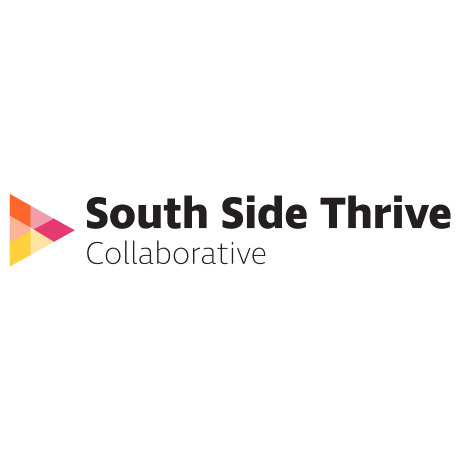Client Case Study
South Side Thrive Collaborative: Collective Impact Initiative Brings Together 40+ Organizations to Drive Lasting Social Change
In 2015, the Mid-Ohio Foodbank received a grant from the Laura and John Arnold Foundation by way of Feeding America, the national network of more than 200 food banks. The Mid-Ohio Foodbank was one of five organizations selected to use this seed funding to pilot a new collective impact and community engagement initiative. Today, this collective impact initiative, known as South Side Thrive Collaborative (SSTC), is an inclusive collaborative of more than 40 actively engaged organizations and several South Side residents striving to improve the health, income mobility, and housing stability for the residents in the South Side of Columbus. SSTC’s Leadership Table includes key community leaders from organizations such as CelebrateOne, Community Development for All People, Crane Group, Donatos Pizza, Engineered Profiles, Marion Franklin Civic Association, Measurement Resources Company, Mid-Ohio Foodbank, Nationwide Children’s Hospital, PrimaryOne, Reeb Avenue Center, South Side Citizen Action Network, and United Way of Central Ohio. SSTC has convened a total of more than 85 organizations since its inception.
Columbus’ South Side neighborhood has a rich history and has been a vibrant community for many years. But in more recent history, many of its community-level indicators—health (including mental health and addiction), unemployment and poverty rates, and infant mortality rates—have warranted an urgent call to action from many community organizations, stakeholders, and residents.
“The charge for SSTC is to develop a collaborative approach amongst these organizations so that we are working toward a common goal and aligning all of our programs and offerings,” said Sarah Lenkay, program director of SSTC through Nationwide Children’s Hospital. “Together, we can streamline and leverage existing programs and resources, design new programs to fill any remaining gaps, and ensure these resources are well known and utilized by South Side residents.”
When SSTC first launched, both the Reeb Avenue Center and the John R Maloney Health Center were fairly new to the South Side, making this one of the immediate priorities for the collective impact initiative participants—to raise awareness among residents and ensure that these resources could be fully utilized.
The Laura and John Arnold Foundation grant also made a meta study possible. SSTC contracted with The Kirwan Institute for the Study of Race & Ethnicity at The Ohio State University to gather, synthesize and analyze all of the most recent studies on the South Side, to help identify common measures. For the past several years, Measurement Resources Company has worked with South Side Thrive Collaborative and all participating organizations to build their data capacity, and to develop an extensive dashboard for tracking and reporting all of the ongoing efforts from across all of the participating organizations. SSTC also hosted a series of community meetings to get input and feedback from community residents to capture their current perspectives and needs.
“Often times, the lift to provide quality and accessible community services and programs keeps us disconnected as organizations,” said Sarah. “SSTC brings them together and gives them a chance to look up, and to identify ways that everyone can collaborate to achieve better outcomes.”
SSTC Achievements to Date
While much of SSTC’s efforts have centered on finding ways to enhance collaboration among its diverse group of partner organizations and residents, ultimately, its purpose is to increase family stability. By creating an integrative collaborative that collectively addresses the root causes of poverty and the intersecting symptoms, SSTC has been particularly focused on housing, health, and income mobility.
“SSTC has also worked hard to enhance communications among community resource providers and residents,” said Sarah. “One recent example of this work in action—COTA recently changed one of its bus routes, which added several stops (and unwanted additional time) for residents who used that line to commute to and from work via Parsons Avenue. SSTC approached COTA with residents’ concerns, and with that feedback, COTA reverted back to its original route.”
In July 2019, SSTC also hosted a community event, which drew more than 60 organizations and businesses, to raise awareness about the “benefits cliff,” so that employers could better understand the gap that can exist between employees’ wages and public benefit programs for lower-income individuals.
Collective Impact and SSTC
In recent years, there has been an influx of significant investments to provide relief to South Side residents. Today, there are more than 100 programs and interventions to help make improvements, including a lot of nonprofits who are focused on this neighborhood, as well as Nationwide Children’s Hospital, and support from the private sector.
“SSTC has been the backbone for creating common goals, so that everyone is working from the same plan to enhance the coordination of services, so that residents can take advantage of resources they need,” said Sarah.
Among the significant investments, there have been several large-scale affordable housing initiatives, as well as incentives for businesses to relocate to the South Side in an effort to increase employment opportunities for local residents. However, with this surge of investments, the fears and realities related to gentrification have also started to crop up.
“SSTC will continue to use its collective voice to help identify and implement additional strategies that will promote and support a mixed income neighborhood,” said Sarah. “We are now looking at how we can keep current residents in their homes and eliminate this underlying fear of displacement.”
Another current area of focus for SSTC, there are currently four or more workforce development agencies that serve South Side businesses and residents, and at least 10 large employers. SSTC has worked to help stratify the offerings of these workforce development agencies. While one may excel at IT credentialing, another may be better at work readiness.
“SSTC will approach potential employers to understand their needs, and refer them to the workforce development agency that best meets those needs,” said Sarah. “This, we believe, will result in enhanced referrals, and a more coordinated point of engagement for employers to find the employees they need, faster.”
The next big undertaking for SSTC, already underway, is to define its objectives for 2020. The collaborative will continue its work to raise awareness about living wages and the benefits cliff, and will continue to link together workforce development organizations and employers, to match open positions in the neighborhood with its local residents. SSTC will continue to build out the infrastructure needed to track the number of South Side employers, and the number of residents who are workforce ready.
“Now that SSTC is well established, we really have the capacity to put all of these pieces into place,” said Sarah. “As I imagine most collective impact initiatives experience, we have been program-rich, but system-poor. But even with this deficiency, we’ve been able to leverage each organization’s strengths and achieve incredible community engagement, with an end-goal of enhancing the overall well-being of all South Side residents.”
More About SSTC
The South Side is a diverse mosaic of communities—coming together and embracing each other to celebrate our uniqueness and differences so that all our neighborhoods are safe, healthy, connected, thriving and equally accessing resources for more enriching lives. To realize its vision, the South Side Thrive Collaborative has formed three work groups that align around a common agenda to develop shared work strategies and that will build a stable, self-supporting South Side community.



